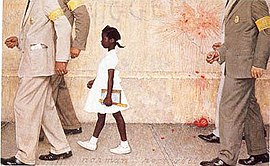The Problem We All Live With
| The Problem We All Live With | |
|---|---|
 | |
| Artist | Norman Rockwell |
| Year | 1964 |
| Type | Oil on canvas |
| Dimensions | 91 cm × 150 cm (36 in × 58 in) |
| Location | Norman Rockwell Museum[1], Stockbridge, Massachusetts |
The Problem We All Live With is a 1964 painting by Norman Rockwell. An iconic image of the civil rights movement in the United States,[2] it depicts Ruby Bridges, a six-year-old African-American girl, on her way into an all-white public school in New Orleans on November 14, 1960 during the process of racial desegregation. Because of threats and violence against her, she is escorted by four deputy U.S. marshals; the painting is framed such that the marshals' heads are cropped at the shoulders.[3][4] On the wall behind her is written the racial slur "nigger" and the letters "KKK"; a smashed tomato thrown at Bridges is also visible. The white crowd is not visible, as the viewer is looking at the scene from their point of view.[3] The painting is oil on canvas and measures 36 inches high by 58 inches wide.[5]
The painting was originally published as a centerfold in the January 14, 1964 issue of Look.[5] Rockwell had ended his contract with the Saturday Evening Post the previous year due to frustration with the limits the magazine placed on his expression of political themes, and Look offered him a forum for his progressive social interests, including civil rights and racial integration.[3] Rockwell explored similar themes in Southern Justice (Murder in Mississippi) and New Kids in the Neighborhood;[6] unlike his previous works for the Post, The Problem We All Live With and these others place black people as sole protagonists, instead of as observers, part of group scenes, or in servile roles.[7][8] Like New Kids in the Neighborhood, The Problem We All Live With depicts a black child protagonist;[7] like Southern Justice, it uses strong light-dark contrasts to further its racial theme.[9]
At Bridges' suggestion, President Barack Obama had the painting installed in the White House, in a hallway outside the Oval Office, from July to October 2011. Art historian William Kloss stated, "It’s a painting that could not be hung even for a brief time in the public spaces [of the White House]. I’m pretty sure of that."[1]
References
- ^ a b Gerstein, Josh (August 24, 2011). "Norman Rockwell painting sends rare White House message on race". Politico. p. 2.
- ^ Solomon, Deborah (2013). American Mirror: The Life and Art of Norman Rockwell. New York: Farrar, Strauss and Giroux. p. 378. ISBN 9780374113094.
- ^ a b c Halpern, Richard (2006). Norman Rockwell: the underside of innocence. University of Chicago Press. pp. 124–31.
- ^ Greene, Bob (September 4, 2011). "America's glory in a civil rights painting". CNN.
{{cite news}}: Invalid|ref=harv(help) - ^ a b ""The Problem We All Live With," Norman Rockwell, 1963. Oil on canvas, 36" x 58". Illustration for "Look," January 14, 1964. Norman Rockwell Museum Collection. ©NRELC, Niles, IL". Norman Rockwell Museum. Retrieved 2011-08-26.
- ^ "O say, can you see". The Economist. December 25, 1993 – January 7, 1994.
- ^ a b Grant, Daniel (July 24, 1989). "Exhibit Offers Clues to Rockwell's Sentiments". Christian Science Monitor.
- ^ "Exile on Main Street". The Economist. December 2, 1999.
- ^ Claridge, Laura P (2001). Norman Rockwell: A Life. Random House.
External Links
- President Obama talking with Ruby Bridges, "The Problem We All Live With" painting (YouTube.com-The White House channel)
